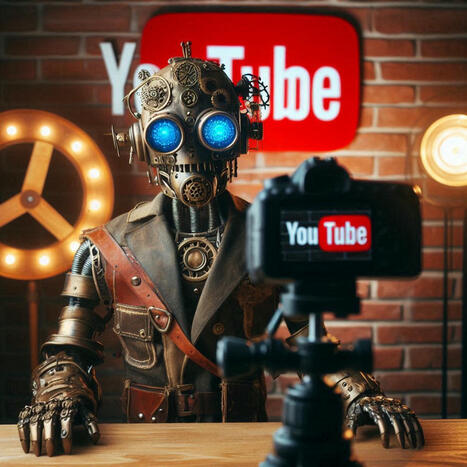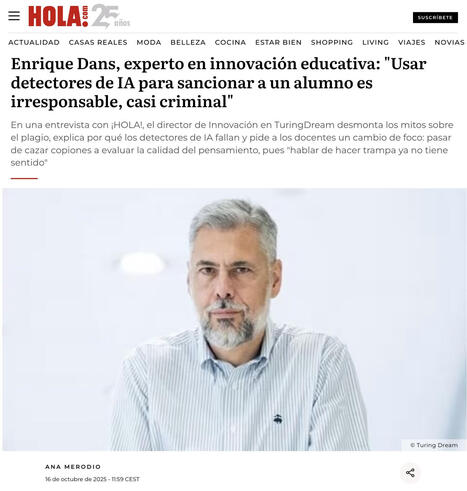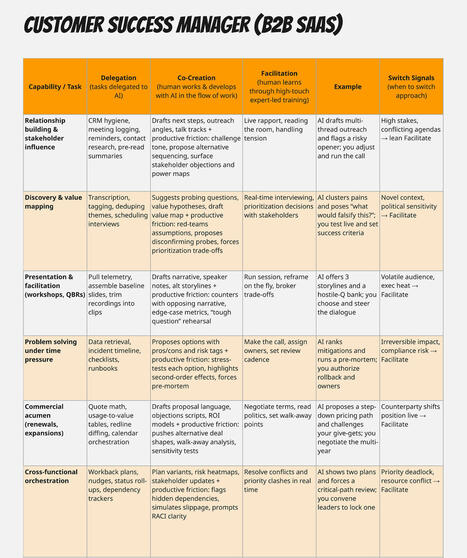I have a confession to make: I love YouTube. There, I’ve said it. At least 30-40% of my viewing content is on this platform – either short form content or longer form material too. Beyond just enjoying the content, I’ve come to appreciate how this platform has fundamentally transformed media creation and consumption. This transformation, I believe, offers fascinating parallels to how AI is reshaping knowledge work and education.
Get Started for FREE
Sign up with Facebook Sign up with X
I don't have a Facebook or a X account


 Your new post is loading... Your new post is loading...
 Your new post is loading... Your new post is loading...
From
substack
La arquitectura de internet atraviesa una metamorfosis que trasciende la mera evolución tecnológica. Lo que algunas voces especializadas denominan Web 3.5 representa, en realidad, la materialización de décadas de convergencia entre sistemas que hasta hace poco operaban en silos diferenciados. Esta fase —más transicional que definitiva— configura el sustrato sobre el que se erigirá una nueva generación de infraestructuras digitales capaz de alterar, de forma estructural, las relaciones entre individuos, organizaciones y sistemas automatizados. 
Ulises La Roca's curator insight,
October 30, 7:10 AM
La arquitectura de internet atraviesa una metamorfosis que trasciende la mera evolución tecnológica.
Colleges are now closing at a pace of one per week. What happens to the students?” Jon Marcus asked in a recent Hechinger Report piece. It’s not a rhetorical question — and it doesn’t have an easy answer. As educators, we’ve read the headlines, seen the numbers, and felt the pressure. Undergraduate enrollment is down. Student confidence is eroding. The enrollment cliff looms.
Edumorfosis's insight:
En Estados Unidos, universidades y colleges están cerrando a un ritmo de una por semana. ¿Qué está pasando con los estudiantes?, preguntó Jon Marcus en su reciente artículo Hechinger Report.
No se trata de una pregunta retórica, y no tiene una respuesta fácil. Como educadores, hemos leído los titulares, hemos visto los números y hemos sentido la presión. La inscripción de pregrado ha disminuido. La confianza de los estudiantes se está erosionando. El precipicio de la inscripción se avecina. El punto de partida es incontestable: los «detectores de texto escrito por inteligencia artificial» no son una base válida para castigar a ningún estudiante. La evidencia lo deja claro: la propia OpenAI retiró su «AI Text Classifier« por su bajo índice de acierto, una admisión explícita de que el enfoque no funcionaba como prometía. La razón de fondo es clara: abundantes falsos positivos y gran facilidad para «engañar» a los detectores. “Artificial Intelligence”. The issue is embedded right in the name: Artificial means not real. Is it here to stay, and can we even fight it? One of our generation’s premier philosophers, Dr. Yuval Harari, said that if we hope to survive, we better fight it (2015). Technology has been hypothesized to be an evolutionary mismatch (Li & Colarelli, 2017). This term implies that behaviors that once supported a species have become injurious. An example of a mismatch is sugary foods. Our nomadic ancestors struggled to procure enough daily calories to sustain life. When they found sugary food, they filled up on it and stored it. In our modern day, too much sugar leads to issues related to early mortality.
From
www
I am not sure that we have quite grasped the enormity of the upheaval that artificial intelligence will bring. The disruption will be orders of magnitude bigger and faster than we have witnessed before, and we won’t have a generation or two to adapt as we had in the industrial revolution. So the question for a place like Oxford is not whether we have Blake’s ‘bow of burning gold’ to fight against AI, but whether we’re up for the challenge – internally and externally – to help humanity adapt, at pace, and to help shape AI into a trusted ally so that human and artificial intelligence co-create a more just, hopeful and kinder society. Building a new story for humans and humanity. And, while I fully recognize the anxiety this new world brings, I say we must get ready.
Edumorfosis's insight:
Cuando una vicerectora ofrece un discurso como este sobre el impacto de la IA en la Educación, tenemos que prepararnos para lo que está por venir. Muchos desconocen aún la magnitud de las capacidades de la IA Agéntica Colaborativa, Sistemas Automatizados-Autónomis y Robótica. Cuando escribí "Derrumbando las Catedrales del Conocimiento" (2019) lo hice pensando en lo que hoy experimentamos con la tecnología algorítmica, metaversos educativos y ecosistemas de aprendizaje aumentados. El 2026 comenzará a abrir el camino de un desarrollo tecnológico sin precedentes. Sara Eston (2023) Existen indicios convincentes, al igual que con las aplicaciones IA, de que esta tecnología avanzada podría volverse omnipresente antes de lo que la persona promedio podría esperar. Si la historia sirve de indicio, cuando la tecnología neuroeducativa llegue a nuestras aulas, es razonable esperar que ni los educadores ni los legisladores puedan restringir o controlar su uso, al menos en la medida que desearían. Desde principios de la década de 2020, los educadores y los responsables de las políticas educativas han estado mal preparados para cambios sociales y tecnológicos a gran escala que escapan de su control. Lo experimentaron primero con el COVID-19 y ahora con la omnipresencia de las aplicaciones IA en el ciclo académico.
AI has renewed debate about learning, memory, and creativity in an age of cognitive offloading. Cognitive offloading means using tools to do mental work we could do ourselves. Many ask if students who use AI to draft essays, solve problems, or recall facts will stop building core skills. These concerns echo older worries about writing, print, calculators, and search engines. History shows that learners adapt. New tools shift what we learn and how we learn it. This report examines how AI-based offloading affects learning, draws on recent research (including Kosmyna et al., 2025) on brain activity with AI writing tools, and argues for responsible AI integration in education. Our core claim is simple: use AI to augment human cognition, not replace it. We offer a brief history, review current evidence, and present recommendations for policy and practice.
Edumorfosis's insight:
La IA ha renovado el debate sobre el aprendizaje, la memoria y la creatividad en una era de descarga cognitiva. La descarga cognitiva significa usar herramientas para hacer un trabajo mental que podríamos hacer nosotros mismos. Muchos preguntan si los estudiantes que usan IA para redactar ensayos, resolver problemas o recordar hechos dejarán de desarrollar habilidades básicas. Estas preocupaciones se hacen eco de las preocupaciones más antiguas sobre la escritura, la impresión, las calculadoras y los motores de búsqueda. La historia muestra que los alumnos se adaptan. Las nuevas herramientas cambian lo que aprendemos y cómo lo aprendemos. Este informe examina cómo la descarga basada en IA afecta el aprendizaje, se basa en investigaciones recientes (incluidas Kosmyna et al., 2025) sobre la actividad cerebral con herramientas de escritura de IA y aboga por una integración responsable de la IA en la educación. Nuestra afirmación principal es simple: usar la IA para aumentar la cognición humana, no reemplazarla. Ofrecemos una breve historia, revisamos la evidencia actual y presentamos recomendaciones para políticas y prácticas. The bulk of the emerging L&D model—the 90%—is about re-coupling work and learning through AI-powered performance support. In practice, this means embedding support and “productive friction” within the workflow itself rather than locating it classrooms or LMSs.
Edumorfosis's insight:
Los defensores del 90/10 argumentan que el modelo no se trata de aprender menos, sino de aprender de manera más inteligente al definir todos los trabajos a realizar como uno de los siguientes:
From
mashable
This is the underlying hum AI has created in academia: my students are using AI to cheat, and there's not much I can do about it. When I asked one professor, who asked to be anonymous, how he catches students using AI to cheat, he said, "I don't. I'm not a cop." Another replied that it's the students' choice if they want to learn in class or not.
Edumorfosis's insight:
No seberíamos caer en el debate contradictorio sobre el uso de la IA en la educación: "Cuando la usan los docentes para sus planes de enseñanza es innovación, pero cuando la usan los estudiantes para hacer sus tareas/proyectos es trampa". La deshonestidad académica es el síntoma, venga de donde venga. La verdadera enfermedad no es la detección de trampas, sino la incapacidad para transformar la metodología instruccional y estrategias de evaluacón efectivas que midan las fuerzas de cambio (desarrollo cognitivo) de los aprendices... Employees across every function are having the same realization: “I need to stay valuable and effective in my role as AI transforms how work gets done.” Organizations face their own version: “We need our workforce to confidently adopt and apply AI capabilities without disrupting productivity or requiring massive retraining investments.” Nos encontramos en el umbral de una transformación que trasciende cualquier revolución pedagógica anterior. La IA no representa simplemente otra herramienta tecnológica que debemos integrar en nuestras aulas; constituye el catalizador de una metamorfosis cognitiva que está redefiniendo la naturaleza misma del pensamiento, el aprendizaje y la construcción del conocimiento humano. Según Tarrant, la IA presenta oportunidades concretas para simplificar tareas rutinarias, lo que facilita que los educadores enfoquen su trabajo en aspectos significativos, como el análisis profundo o la creatividad. Esta perspectiva redefine el rol del profesor en la escuela y en la universidad, donde la transmisión mecánica de conocimientos cede ante la promoción de la reflexión, el debate y la generación de ideas propias por parte de los estudiantes . Gardner, speaking during a forum Wednesday at the Harvard Graduate School of Education, called AI as fundamental a change to education as the world had seen in 1,000 years — and even said it may render obsolete many of the forms of mind he is famous for describing.
Edumorfosis's insight:
Lo dice una eminencia del campo educativo: Howard Gardner, conversando en un foro de la Escuela Graduada de Educación de Harvard, calificando a la IA como un cambio fundamental en la Educación como el mundo había visto en 1,000 años, e incluso dijo que puede hacer obsoletas muchas de las formas mentales por las que es famoso. La Educación Superior latinoamericana no siempre prepara a los jóvenes para el futuro laboral. Mientras la inestabilidad económica e Inteligencia Artificial transforman el mercado de trabajo, millones de jóvenes quedan atrapados entre la la informalidad y la desigualdad.
Edumorfosis's insight:
El fenómeno de la baja tasa de inscripción a las instituciones universitarias experimenta una diversidad de variables que se deben investigar con detenimiento. Las variables son diferentes en cada nación. Lo que preocupa hoy día es el aumento de jóvenes que creen que la universidad ha perdido su relevancia en el mundo moderno y que no es tan necesaria para tener éxito en la vida. Muchas personas creen que la universidad no es la única opción a seguir para formar parte de la sociedad contemporánea. El modelo rígido de las universidades deja a fuera a muchos jóvenes que quisieran vivir la experiencia. La oferta académica existente tampoco atrae a muchos egresados de la escuela superior. El por ciento de jóvenes que consiguen empleo en lo que estudiaron está por debajo del 50%. Las tasas de colocación presentan números por debajo de la media. En algunas regiones, hay escasez de ofertas de empleo en carreras profesionales. Y en algunos casos, los egresados universitarios no cuentan con el perfil profesional que el mercado laboral emergente está buscando. |
AI Chatbots — including ChatGPT and Gemini — often cheer users on, give them overly flattering feedback and adjust responses to echo their views, sometimes at the expense of accuracy. Researchers analyzing AI behaviours say that this propensity for people-pleasing, known as sycophancy, is affecting how they use AI in scientific research, in tasks from brainstorming ideas and generating hypotheses to reasoning and analyses.
Edumorfosis's insight:
Los modelos IA son un 50% más aduladores que los humanos, según un análisis publicado este mes. El estudio examinó cómo 11 modelos LLM utilizados para responder más de 11,500 consultas en busca de consejos, incluidas muchas situaciones que describían irregularidades o daños.
En Austin, Texas, un colegio comprime en dos horas lo que cualquier otro hace en ocho. Todas las asignaturas, de matemáticas a lengua, caben ahí. El resto del tiempo, los alumnos lo dedican a otras actividades: hablar en público, trabajar en equipo o sencillamente realizar un proyecto personal. Se deja espacio para el desarrollo de habilidades blandas. Durante años nos han repetido que estamos ante la “generación mejor preparada”, pero los datos cuentan otra historia. Este video desvela cómo detrás del aumento de escolarización se esconde una caída alarmante en la calidad educativa. Jóvenes con másteres pero sin competencias reales, universidades convertidas en fábricas de diplomas y un sistema incapaz de preparar para el futuro digital. Analizamos el mito del progreso educativo, los factores que lo alimentan y cómo afecta a la sociedad, la economía y la libertad individual. Si crees que estudiar más equivale a saber más... este video te hará dudar.
Edumorfosis's insight:
Siempre hemos escuchado la frase de que los jóvenes de hoy son la generación mejor preparada. El númeno de jóvenes con estudios universitarios va en aumento, en comparación con generaciones anteriores. Por tanto, se cree que mientras más estudien, más aprenderán. Estudios indican que es todo lo contrario. Marc Vidal reflexiona sobre este interesante tema educativo... Teachers are tough to crack. Thomas Edison believed film would replace teachers1, BF Skinner believed they would be replaced by ‘teaching machines’ and Sal Khan (of Khan Academy) argued in ~2015 that information transfer would soon primarily happen through video.2 Perhaps the reason these predictions were wrong is that we still don’t fully understand what great teaching is. It’s instruction and mentorship and coaching and pastoral support combined in a complex combination. There is a reason why Jean-Jacques Rousseau believed he would only be able to teach one other person in his lifetime, and at a stretch. Now some think AI puts teaching jobs at risk but I don’t think this is right for three reasons. Los autores de "Which Humans?", de la Universidad de Harvard, cuestionan el tan mencionado "rendimiento humano" ejecutado en los Modelos de Escala Grande (LLM) de Inteligencia Artificial. Los autores argumentan que los humanos son una especie multicultural que presenta una diversidad psicológica sustancial en todo el mundo, una diversidad que los datos textuales utilizados para entrenar los LLMs no logran capturar completamente. Los hallazgos de su investigación demostraron que las respuestas de los LLM a las mediciones psicológicas son valores atípicos en comparación con los datos transculturales a gran escala. I’m going to make a deliberately provocative statement: generative AI is not a source of information. Now, before the technically minded among you start typing furious corrections, let me clarify what I actually mean.
Edumorfosis's insight:
Un LMS es un motor de coincidencia de patrones probabilísticos. Eso es una simplificación, y estoy seguro de que las personas que saben mucho más sobre LLM que yo vendrán y me dirán lo equivocado que está eso. Pero esencialmente, es estocástico. Está haciendo predicciones basadas en patrones en lo que le ha pedido, patrones en sus datos de entrenamiento, los pesos que se le han dado, el aprendizaje por refuerzo al que se ha sometido y la configuración de temperatura a la que se está ejecutando. Los modelos están entrenados explícitamente para reproducir información con precisión, a través de conjuntos de datos masivos, algoritmos de optimización y aprendizaje por refuerzo a partir de comentarios humanos.
Los LLM tienen un proceso consistente pero producen resultados inconsistentes. Puede confiar absolutamente en que un modelo de lenguaje grande genere patrones que coincidan con lo que se ha programado para que coincida en función de su entrada y sus datos de entrenamiento. Eso es 100% confiable. En lo que no puede confiar es en que esos patrones serán precisos, completos o incluso iguales de una consulta a la siguiente. Prepare students for a future where AI Tutors, emotion-aware classrooms, and immersive VR lessons are the norm — and discover what’s quietly reshaping education behind the scenes.
Edumorfosis's insight:
La Cibergogía es inminente en la Educación estadounidense. Los docentes y estudiantes tendrán que enseñar, aprender y trabajar con TutoresIA, RV Inmersiva y Conciencia Emocional en sus experiencias de aprendizaje. Pero, ¿quién preparará a los docentes y estudiantes en Cibergogía? ¿Los TutoresIA? ¿Los AgentesIA? ¿Los docentes? ¿El sistema educativo?
From
www
When ChatGPT first appeared in November 2022, many educators and academic institutions responded with blanket bans, unsure whether these tools were more likely to spark innovation or cheating. The jury is still out on that, but administrators have started to relax some policies and give teachers greater freedom to direct when they can be used. How these tools are used, however, is often driven by students. Cada año, Chegg tiene como objetivo descubrir las perspectivas de los estudiantes sobre los problemas clave más apremiantes que dan forma a sus vidas, desde las finanzas y la salud mental hasta la creciente influencia de la tecnología y sus esperanzas para el futuro. En la Encuesta Global de Estudiantes 2025 les formularon una amplia gama de preguntas sobre el uso de la IA Generativa, cómo creen que cambiaría el panorama educativo y cómo deberían reaccionar las instituciones en respuesta.
El análisis detallado de los hallazgos del estudio sobre la IA Gen en la Educación se centrará en la adopción, los beneficios, la visión de los estudiantes sobre el panorama educativo y las expectativas hacia las instituciones. En Oppenheimer Presenta hablamos con expertos en educación e inteligencia artificial sobre las nuevas escuelas sin maestros y basadas en IA que empezaron a ponerse de moda en Estados Unidos. ¿Son efectivas? ¿Están al alcance de todos? ¿Qué cambios produce en la formación de los niños?
Edumorfosis's insight:
No es que esté a favor de la sustitución total de los maestros por Tutores IA, ni que este modelo educativo algorítmico sea mejor que la Educación Tradicional. Es que la IA va a llegar para cambiar los roles docentes, de transmisores de contenidos a guías, supervisores y acompañantes del desarrollo cognitivo de sus alumnos. Las Escuelas Alpha y AI-Primer Micro-School, ya están lanzándose en diversos estados norteamericanos. A top Google scientist and 2024 Nobel laureate said Friday that the most important skill for the next generation will be “learning how to learn” to keep pace with change as Artificial Intelligence transforms education and the workplace.
Edumorfosis's insight:
Nuestro sistema educativo actual está diseñado para operar en una era post-industrial del conocimiento que ha dejado de existir. El sistema prioriza la memorización de hechos, datos y la repetición de tareas especializadas de dominio específico. Necesitamos una reestructuración completa que deje de enseñar el "qué pensar" y comience a enseñar "cómo aprender". Las implicaciones del learnability (aprenibilidad) en la fuerza laboral son mucho más profundas. La naturaleza de las tareas laborales cambiarán con una frecuencia nunca antes vista. Aquellos trabajadores que definan su identidad profesional por una sola habilidad rígida (expertos en un solo dominio) estarán extremadamente expuestos a ser sustituidos por la IAGeneral. La ventaja competitiva residirá en aquellos que puedan navegar la incertidumbre y aprender activamente en nuevos campos.
From
www
The Middle States Commission on Higher Education (MSCHE) continues to encourage innovation in higher education. The Commission has approved new Use of Artificial Intelligence Policy and Procedures that reflect this commitment and incorporate emerging research and best practices in this areas:
Edumorfosis's insight:
La política y los procedimientos de la MSCHE establecen amplias expectativas para el uso legal, ético, transparente y seguro de la IA. Las instituciones deben garantizar que la gobernanza, la contratación y el uso de la IA estén alineados con los Estándares de Acreditación y Requisitos de Afiliación de la Comisión, la política, los procedimientos, la ley aplicable, así como con las propias políticas de la institución.
Las instituciones universitarias que utilizan herramientas y plataformas IA deben incorporarla dentro de las políticas y procedimientos existentes de gobernanza de datos y seguridad de la información. La MSCHE no propugna una herramienta o plataforma IA específica para las actividades de acreditación, pero permitirá el uso de la IA para la preparación de materiales de acreditación. Las instituciones serán responsables de la exactitud e integridad de todos los materiales desarrollados y presentados en su nombre a la MSCHE. Los procedimientos también abordan las expectativas de uso de la IA por parte del personal de la MSCHE. |











![[PDF] Global Learning & Skills Trends Report 2026 | Edumorfosis.it | Scoop.it](https://img.scoop.it/aP2wFGi4vC13vLhNhBdjCDl72eJkfbmt4t8yenImKBVvK0kTmF0xjctABnaLJIm9)



















